[49 Pa.B. 2103]
[Saturday, April 27, 2019]
[Continued from previous Web Page]

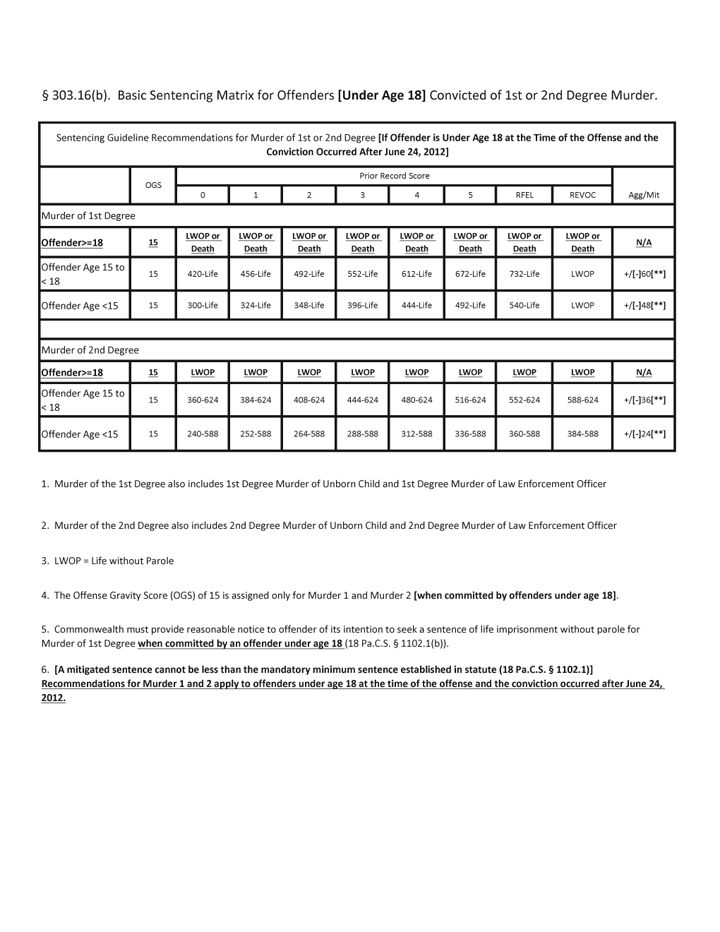
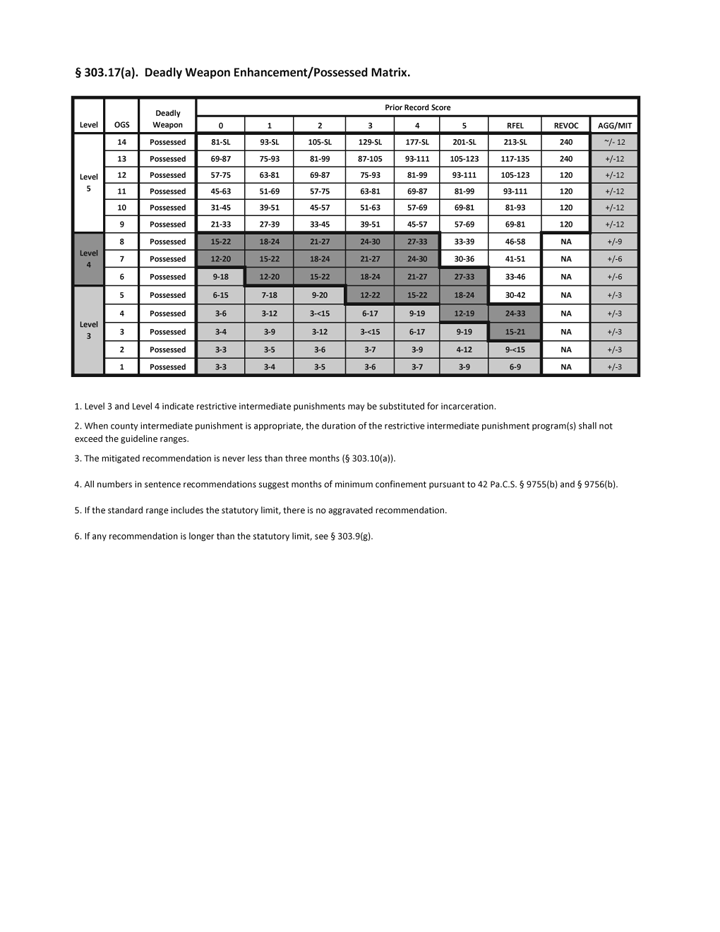
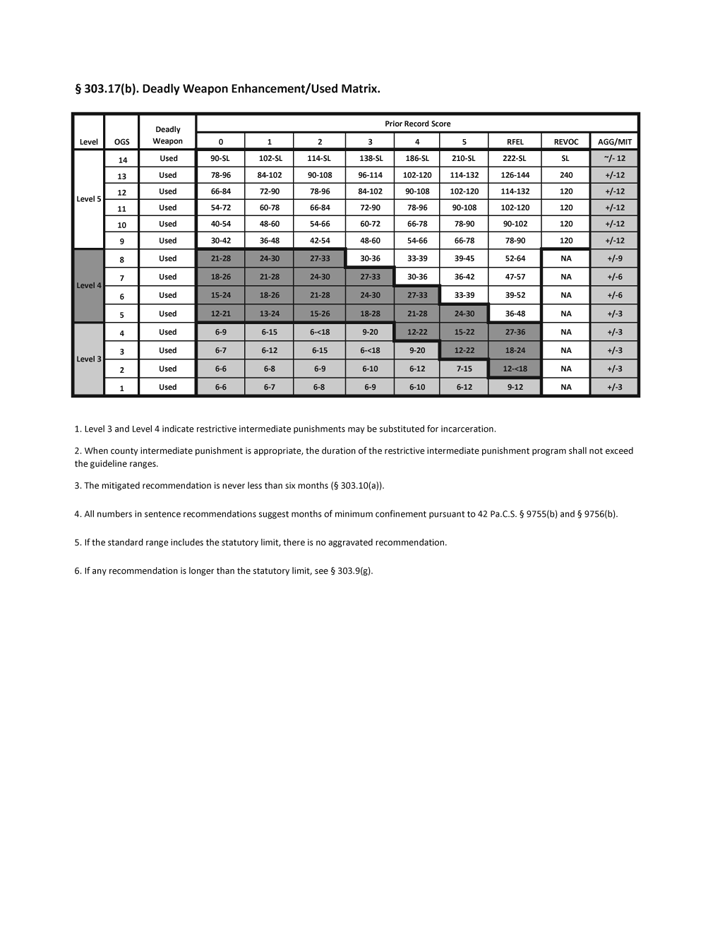
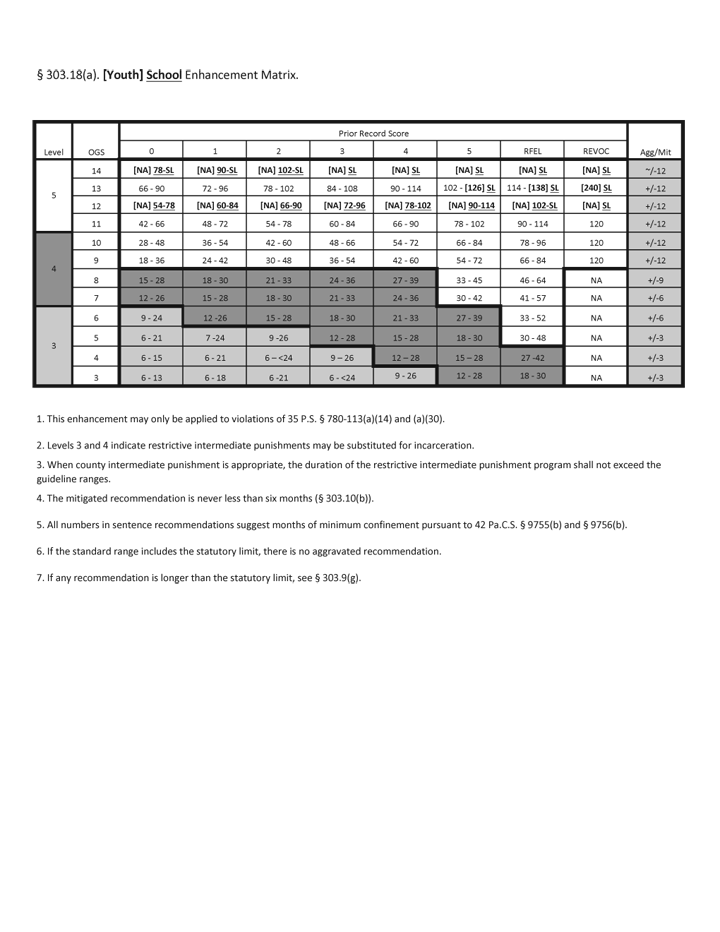

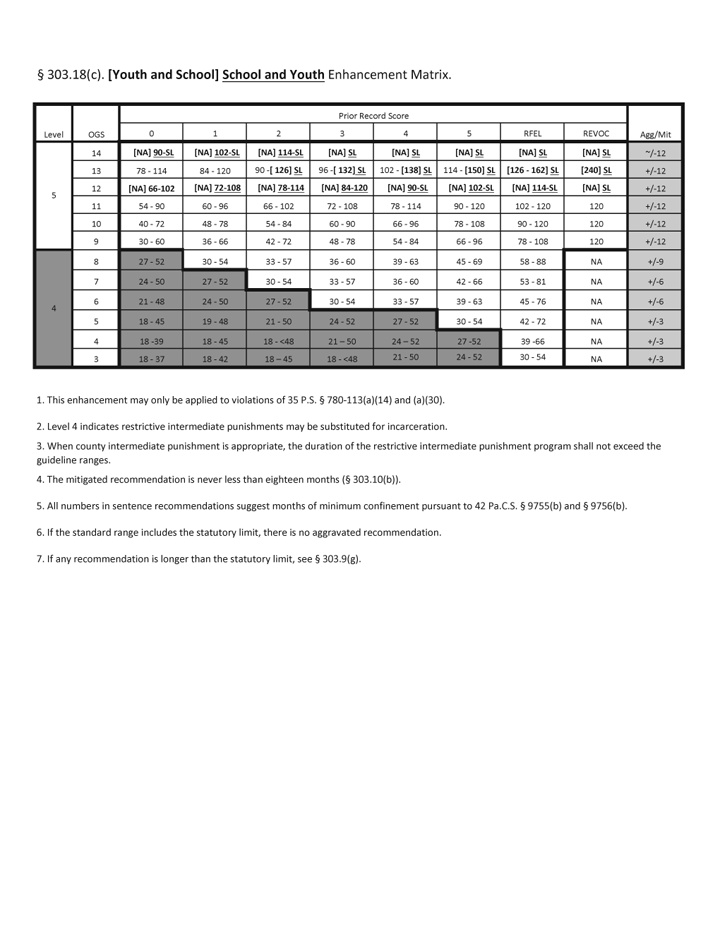
Commentary on Annex B This Commentary provides information on the proposed Resentencing Guidelines. The proposed Resentencing Guidelines are set forth in Annex B.
Publication of Proposed Resentencing Guidelines
The proposed Resentencing Guidelines, if adopted, will be published in the Pennsylvania Code with other documents proposed or adopted by the Commission:
Chapter 303—Sentencing Guidelines
Chapter 305—Sentence Risk Assessment Instrument
Chapter 307—Resentencing Guidelines
Chapter 309—Parole Guidelines
Chapter 311—Recommitment Ranges
Proposed 307.1—Preliminary Provisions
This proposed section provides the legislative authority for the adoption of Resentencing Guidelines. Act 81 of 2008, 42 Pa.C.S. § 2154.4, requires the following:
The commission shall adopt guidelines that shall be considered by the court when resentencing an offender following revocation of probation, county intermediate punishment or State intermediate punishment. The guidelines shall take into account:
(1) Factors considered in adopting the sentencing guidelines,
(2) The seriousness of the violation and
(3) The rehabilitative needs of the defendant.
This proposed section also sets forth definitions for the terms used in Chapter 307.
Proposed 307.2—Resentencing Guidelines standards
This proposed section provides the requirements for consideration of the Resentencing Guidelines and the reporting of information to the Commission. As required by the legislation, Resentencing Guidelines shall be considered by the court when imposing a new sentence following revocation of probation, county intermediate punishment or state intermediate punishment. Resentencing Guidelines do not apply to revocations of parole. All revocations of probation, county intermediate punishment and state intermediate punishment and subsequent resentences shall be reported through the Commission's JNET-based SGS Web application.
A Revocation/Resentencing module was developed within SGS Web, the Commission's JNET-based sentencing application. Counties voluntarily reported revocations and resentences beginning in November of 2011. With 7th Edition Amendment 3 Sentencing Guidelines, the Commission required reporting any sentence of probation, county intermediate punishment or state intermediate punishment imposed on or after January 1, 2016 that was subsequently revoked and reporting the resentence. These data were used in developing the proposed Resentencing Guidelines. The Commission will continue to utilize this module within SGS Web for the reporting of revocations and resentences.
Proposed 307.3—Procedures for determining the guideline resentence
This proposed section provides the procedures for determining the guideline resentence recommendation, accounting for the factors considered in the initial sentencing guidelines and the seriousness of the violation. The initial sentencing guidelines, based on the offense gravity score for the initial conviction offense and the prior record score, as well as any applicable enhancements, serve as the starting point for Resentencing Guidelines, and apply to all technical violations. For more serious conviction violations, the initial sentence recommendation is generally enhanced.
Violations of the terms and conditions of probation, county intermediate punishment or state intermediate punishment are determined by the court following a hearing. A technical violation involved the failure to comply with the terms and conditions of supervision, other than the commission of a new offense for which the offender is convicted in a court of record. A conviction violation involves the failure to comply with terms and conditions through the commission of a new offense during the period of supervision, and resulting in a conviction for a misdemeanor or felony in a court of record, whether or not judgement of sentence has been imposed.
Proposed 307.4—Guideline resentence recommendations
This proposed section recommends consideration of a risk-needs or a risk-needs-responsivity assessment prior to resentencing to address the rehabilitative needs of the offender. Underlying issues of drug or alcohol dependency, mental illness or other needs may be identified through an assessment and may inform decisions at resentencing that reduce the of future violations, including new offenses.
When resentencing, this proposed section also requires consideration of the recommendations related to sentencing levels, sentencing programs, aggravated and mitigated circumstances, and economic sanctions provided for in the Sentencing Guidelines.
Annex B
TITLE 204. JUDICIAL SYSTEM GENERAL PROVISIONS
PART VIII. CRIMINAL SENTENCING
CHAPTER 307. RESENTENCING GUIDELINES (Editor's Note: The following chapter is proposed to be added and is printed in regular type to enhance readability.)
Sec.
307.1. Preliminary provisions. 307.2. Resentencing Guidelines standards. 307.3. Procedure for determining the guideline resentence. 307.4. Guideline resentence recommendations. § 307.1. Preliminary provisions.
(a) Authorization.
(1) As authorized by 42 Pa.C.S. § 2154.4 (relating to guidelines for resentencing), the Commission shall adopt guidelines that shall be considered by the court when resentencing an offender following the revocation of probation, county intermediate punishment, or state intermediate punishment.
(2) The Resentencing Guidelines shall take into account:
(i) factors considered in adopting the sentencing guidelines,
(ii) the seriousness of the violation, and
(iii) the rehabilitative needs of the defendant.
(b) Definitions. For the purposes of this chapter:
(1) ''Conviction.'' A finding of guilty or the entering of a plea of guilty or nolo contendere for a misdemeanor or felony in a court of record, whether or not judgement of sentence has been imposed.
(2) ''County intermediate punishment (CIP).'' A sentencing alternative as provided in 42 Pa.C.S. Chapter 98 and imposed pursuant to 42 Pa.C.S. § 9763.
(3) ''Court.'' A court of record.
(4) ''Judicial proceeding.'' A sentencing hearing in which all offenses for which the offender is convicted are pending before the court for sentencing at the same time. A judicial proceeding may include multiple OTNs.
(5) ''Offense gravity score (OGS).'' An assignment in the sentencing guidelines reflecting the seriousness of a conviction offense (see: 204 Pa. Code § 303.3 and § 303.15).
(6) ''Offense tracking number (OTN).'' A unique identifying number assigned to an entire set of charges related to a conviction. An OTN is generally assigned by the court at the time of arraignment.
(7) ''Prior record score (PRS).'' A category in the sentencing guidelines reflecting the seriousness of the criminal history of an offender (see: 204 Pa. Code § 303.4).
(8) ''Probation.'' A sentencing alternative as provided in 42 Pa.C.S. § 9722 and imposed pursuant to 42 Pa.C.S. § 9754.
(9) ''Resentence.'' A new sentence imposed following the revocation of probation, county intermediate punishment, or state intermediate punishment. Upon revocation, the sentencing alternatives available to the court shall be the same as were available at the time of the initial sentence.
(10) ''Revocation.'' The termination of an order of probation or a sentence of county intermediate punishment or state intermediate punishment, upon proof of a violation of specific conditions of the order or sentence, as provided in 42 Pa.C.S. §§ 9771 and 9771.1 (relating to revocation of probation), 42 Pa.C.S. § 9773 (relating to revocation of county intermediate punishment), and 42 Pa.C.S. § 9774 (relating to revocation of state intermediate punishment).
(11) ''Risk assessment instrument.'' An empirically based worksheet which uses factors that are relevant in predicting recidivism. A risk assessment instrument is often identified with a specific 'generation' of development:
i. 1st generation. ''Professional judgment,'' with assessments based on training and experience;
ii. 2nd generation. ''Risk assessment,'' an actuarial assessment of static criminal justice and demographic factors used to estimate risk of re-offense;
iii. 3rd generation. ''Risk-needs assessment (RNA),'' an actuarial assessment of static and dynamic factors and changing circumstances, such as relationships, employment, and substance abuse, used to estimate risk of re-offense and to assess criminogenic needs to be addressed through treatment and supervision;
iv. 4th generation. ''Risk-needs-responsivity (RNR) assessment,'' an actuarial assessment of static and dynamic factors used to match the level of service to the offender's risk to re-offend; assess criminogenic needs and target them in treatment; and structure the sentence to address the learning style, motivation, abilities and strengths of the offender.
(12) ''Sentencing Guidelines Software Web Application (SGS Web).'' A JNET-based application operated by the Commission which includes the modules for Sentencing Guidelines and for Resentencing Guidelines. SGS Web serves as the source of data for the original reported sentence and associated information and the reporting source for revocations and resentences.
(13) ''State identification number (SID).'' A unique number associated with each offender based on fingerprints. The Commission requires the inclusion of SID as part of the record in the completed Guideline Sentence Form (§ 303.1(f)).
(14) ''State intermediate punishment (SIP).'' A sentencing alternative as provided in 61 Pa.C.S. Chapter 41 and imposed pursuant to 61 Pa.C.S. § 4104(d).
(15) ''Violation.'' A finding by a court of record, following a hearing, that the offender failed to comply with terms and conditions of an order of probation or a sentence of county intermediate punishment or state intermediate punishment.
i. ''Technical violation.'' Failure to comply with the terms and conditions of an order of probation or a sentence of county intermediate punishment or state intermediate punishment, other than by the commission of a new offense of which the offender is convicted in a court of record.
ii. ''Conviction violation.'' Commission of a new offense during the period of probation, county intermediate punishment or state intermediate punishment, resulting in a conviction for a misdemeanor or felony in a court of record, whether or not judgement of sentence has been imposed.
§ 307.2. Resentencing Guidelines standards.
(a) The court shall consider the Resentencing Guidelines in determining the appropriate resentence upon a revocation of probation, county intermediate punishment, or state intermediate punishment.
(b) Effective for sentences imposed on or after January 1, 2020, the Resentencing Guidelines shall apply to all subsequent revocations of probation, county intermediate punishment, and state intermediate punishment and resentences imposed as of January 1, 2020 and subsequently revoked and resentenced. Amendments to the Resentencing Guidelines shall apply to sentences imposed on or after the effective date of the amendments, and shall be considered for all subsequent revocations of probation, county intermediate punishment, and state intermediate punishment and resentences.
(c) Upon revocation of probation, county intermediate punishment, or state intermediate punishment, all sentencing alternatives available to the court at the time of the initial sentence shall be available to the court for resentencing.
(d) In every case in which a court of record imposes a resentence for a felony or misdemeanor, the court shall make as a part of the record and disclose in open court at the time of resentencing, a statement of the reason or reasons for the revocation and for the resentence imposed. In every case where a court of record imposes a resentence outside the Resentencing Guidelines, the reason or reasons for the deviation from the guidelines shall be recorded on the Guideline Sentence Form, a copy of which shall be electronically transmitted to the Pennsylvania Commission on Sentencing in the manner described in 204 Pa. Code § 303.1(e).
(e) Unless otherwise provided by the Commission, the JNET-based Sentencing Guidelines Software Web application (SGS Web) shall be used at the court's direction to report all revocations of probation, county intermediate punishment, and state intermediate punishment and related resentences to the Commission. The information shall be electronically submitted to the Commission via SGS Web no later than 30 days after the date of resentencing.
§ 307.3. Procedure for determining the guideline resentence.
(a) For a technical violation resulting in the revocation of an order of probation or a sentence of county intermediate punishment or state intermediate punishment, the re-sentencing guidelines shall be the same as the initial sentencing guidelines, pursuant to 204 Pa. Code Chapter 303 (relating to sentencing guidelines).
(b) For a conviction violation resulting in revocation of an order of probation or a sentence of county intermediate punishment or state intermediate punishment, the re-sentencing guidelines shall begin with the initial sentencing guidelines, pursuant to 204 Pa. Code Chapter 303 (relating to sentencing guidelines), and include consideration of the following:
(1) If the PRS category of the initial sentencing guidelines is PRS 0 through PRS 4, the PRS is increased by one category;
(2) If the PRS category of the initial sentencing guidelines is PRS 5, RFEL, or REVOC, there is no change to the PRS category.
(c) If the revocation of an order of probation or a sentence of county intermediate punishment or state intermediate punishment is related to both a technical violation and a conviction violation, the resentencing guidelines for the conviction violation apply.
§ 307.4. Guideline resentence recommendations.
(a) Prior to resentencing, the Commission recommends the court obtain additional information via a risk-needs assessment or a risk-needs-responsivity assessment to identify any rehabilitative needs that may be addressed in a resentence.
(b) Guideline resentencing recommendations relating to sentencing level, sentencing programs, aggravated and mitigated circumstances, and economic sanctions shall the same as those provided for guideline sentence recommendations pursuant to 204 Pa. Code §§ 303.11, 303.12, 303.13 and 303.14.
[Pa.B. Doc. No. 19-647. Filed for public inspection April 26, 2019, 9:00 a.m.]
No part of the information on this site may be reproduced for profit or sold for profit.This material has been drawn directly from the official Pennsylvania Bulletin full text database. Due to the limitations of HTML or differences in display capabilities of different browsers, this version may differ slightly from the official printed version.